Please Take Note: This is a review of the game’s final prototype. The art, game bits, and the rules discussed are all subject to change. The game is being reviewed on the components and the rules provided with the understanding that “what you see is not what you might get” when the game is published. If you like what you read and want to learn more, we encourage you to visit the game’s web page or visit the Kickstarter campaign. Now that we have all that disclaimer junk out of the way, on with the review!
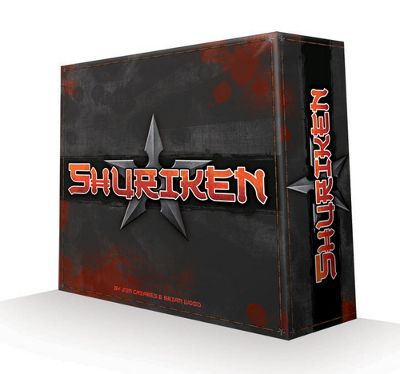
The Basics:
- For ages 8 and up (publisher suggests 14+)
- For 2 to 5 players
- Approximately 90 minutes to complete
Geek Skills:
- Active Listening & Communication
- Counting & Math
- Logical & Critical Decision Making
- Reading
- Strategy & Tactics
- Hand/Resource Management
- Worker Placement & Area Control
Learning Curve:
- Child – Easy
- Adult – Easy
Theme & Narrative:
- Lead your Ninja Clan to claim the title of Master of Clans
Endorsements:
- Gamer Geek approved!
- Parent geek approved!
- Child Geek approved!
Overview
Every 10 years, the Ninja Clans gather to select one among them to be the Master of Clans. The selection process is simple. All the clans will select their most skilled Ninja and silently infiltrate the most secure area in the world: the Royal Palace. There, the clans will duel for one evening, unseen and undetected by the Royal Guard. When dawn breaks, one clan will emerge supreme. From this clan, the Master of Clans will be selected and lead for another 10 years.
Shuriken, designed by Jon Cazares, Brian Wood, and to be published by Awesome Enterprises, will reportedly be comprised of 12 double-sided modular game board tiles, 250 28mm plastic Ninja miniatures (representing 4 different Ninja types in 5 different colors, 50 per color), 20 Hour of Night cards, 80 Mission Cards, 5 Clan Cards, 10 custom six-sided dice, and 42 tracking tokens. As this is a review of a prepublished version of the game, we will not comment on the game component quality. Heck, I can’t even comment on the Ninja miniatures! Instead of 250 silent death Ninjas of awesomeness, we were provided 250 brain eating Zombie miniatures. Which is a different kind of cool…
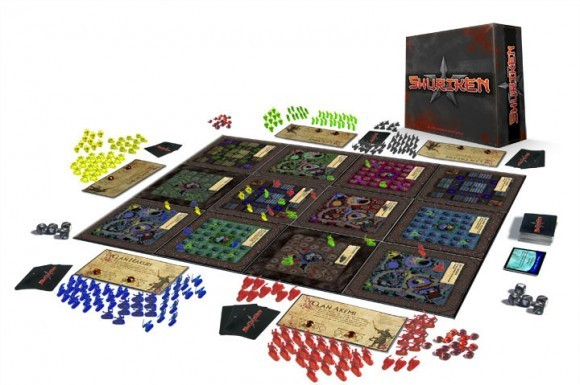
An example of what the game will look like once it’s published
Game Set Up
To set up the game, first have each player select one of the 5 available colors of Ninja miniatures. Players take all the Ninja miniatures of that color (50 in total) and should take a moment to separate them by type. In total, there are 4 different types. These are “Unarmed”, “Shuriken”, “Sword”, and “Master”. The total number of Ninjas the player can use in the game is referred to as the player’s “Ninja pool”. Any unused Ninja miniatures are returned to the game box.
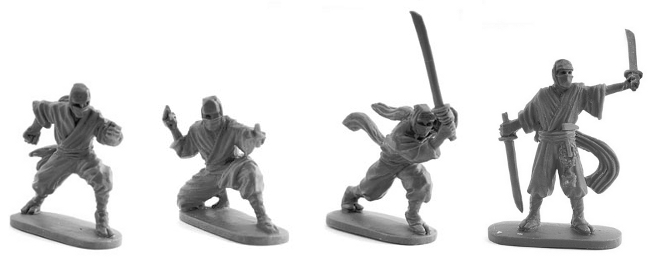
From left to right: “Unarmed”, “Shuriken”, “Sword”, and “Master” Ninjas
Second, have each player select a Clan card or deal them out randomly. Any unused Clan cards are returned to the game box. Pass to each player 2 tracker tokens and have them place the tokens on the lowest number values found on their Clan cards for the “# Ninja Move” and “# Spaces Move”. Place the rest of the tracker tokens and the dice to one side of the game playing area in separate piles.
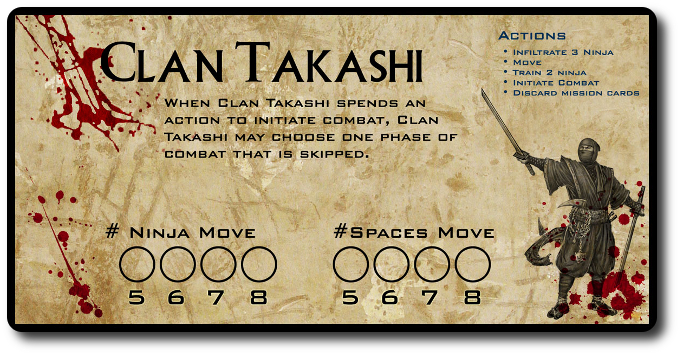
Third, randomly distribute the game board tiles to create a 3 x 4 square grid, making sure the “Zen Garden” and the “Palace” game board tiles are in opposite corners. The game board tiles are double-sided. One side shows the represented area undamaged and the other shows the same area burned and broken. When placing the tiles, make sure the undamaged area is facing up. If playing a 2 or 3 player game, create a 3 x 3 grid returning the unused game board tiles to the game box. Regardless of number of players, the “Palace” and the “Zen Garden” should always be used.
Fourth, shuffle the Mission cards and deal 3 to each player, face-down. These are the players’ starting secret missions. The remaining Mission cards should be placed to one side of the game playing area, face-down. Make sure to leave room for a discard pile.
Fifth, shuffle the Hour of Night cards and randomly deal 10 cards face-down. Keep these 10 cards face-down and place them in a single deck next to the Mission deck. Make sure to leave room for a discard pile. Any undealt Hour of Night cards are returned to the game box.
Sixth, determine who will be the first player. Starting with the first player and going in turn order sequence (going clockwise around the table), each player will place a total of 1 “Master” Ninja and 2 “Unarmed” Ninjas, one at a time, on any game board tile that allows a Ninja to infiltrate. Ninja miniatures cannot occupy the same square space within a game board tile and Ninjas of the same clan can be split up across multiple tiles.
That’s it for game set up! Time to be silent and deadly…
Of Death and Shadow
Shuriken is played over the course of 10 rounds. Each round is 1 hour of the evening. The number of rounds left in the game is tracked using the 10 Hour of Night cards dealt face-down during the game set up.
During a game round, a player can take up to 3 different actions. There are a total of 5 available action types the player can spend their actions on. Depending on the Hour of Night card currently in play, the Clan card, and the game board tile the player is moving on, through, or fighting on, some of the action types might require additional steps or have additional rules that supersede the basic rules. A typical player’s turn is summarized here.
Step 1: Reveal the Hour
The first step, and only done by the first player at the beginning of every round, is to reveal a new Hour of Night card. The card’s effects are now active for the duration of the round. Any previously played Hour of Night cards are discarded. In this way, only 1 Hour of Night card is ever active. If the current player taking their turn for the round is not the first player, this step is skipped.
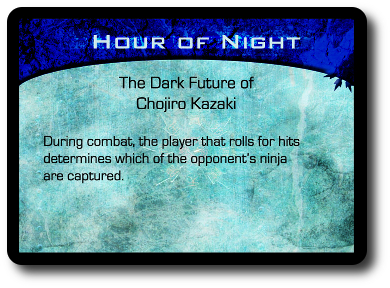
Step 2: Take Actions
A player can take 3 actions on their turn. There are 5 different action types the player can select from. From these 5 action types, the player can choose to do any they like, in any order, and repeat the same action types multiple times. The action types are summarized here.
Infiltrate
This action allows the player to place up to 3 “Unarmed” Ninjas from their Ninja pool onto any game board tile that they currently have other Ninjas occupying and any game board tile that allows Ninjas to infiltrate. When placing the miniatures, only 1 Ninja can occupy a single square on the game board tiles. It’s important to note that a player is only using 1 action to place up to 3 “Unarmed” Ninjas. The player can place less than 3 if they think it wise. If the player does not have any “Unarmed” Ninjas available to place, this action cannot be taken.
Train
This action allows the player to replace any 2 “Unarmed” Ninjas that are currently on the game board tiles with 2 of any other Ninja type (Sword, Shuriken, or Master). For example, the player can replace the “Unarmed” Ninjas with a “Sword” and a “Shuriken” Ninja or two “Shuriken” Ninjas. The newly placed Ninja must come from the players Ninja pool and must occupy the same square the “Unarmed” Ninjas occupied. The removed “Unarmed” Ninja is placed back in the player’s Ninja pool. The only limiting factor, other than having different Ninja types available, is that a player can only have 1 “Master” Ninja on the game board tiles at a time, unless otherwise noted by a Mission or a Clan card.
Move
This action allows the player to move a number of Ninjas a number of square spaces on the game board tiles. The number of Ninjas that can be moved and the total number of squares spaces each Ninja can travel through is tracked on the player’s Clan card. Any Ninja the player has on the game board tiles can be moved.
A “square space” is defined as any square grid area on an individual game board tile. Note that some of the square spaces are larger than others. These still count as only 1 square space. Some square spaces have a red outlines. These represent walls and other obstacles that cannot be moved through. When moving, Ninjas can travel in any direction (straight or diagonal). Ninjas can travel through square spaces occupied by Ninjas (even Ninjas from rival clans), but can never end their movement on a square space that already contains a Ninja. Ninjas’ have “personal space” issues.
Players can increase the total number of Ninjas moved and total square spaces that can be traveled through by completing Mission cards.
Initiate Combat
This action initiates combat between all the clans on a single game board tile. Since we are dealing with Ninjas, combat is swift and deadly, but it’s also structured and highly disciplined with specific rules of engagement. When a player initiates combat, all the clans that occupy the same game board tile will battle. This means that a player best think twice before drawing their sai, especially if they are outnumbered. A wise Ninja knows that it’s often best to stick to the shadows and strike the enemy from concealment. But sometimes that is not possible and combat will ensue.
There are 3 phases of combat. During each phase, all the players who have Ninjas located on the game board tile where the combat is taking place will participate. One die is taken by each player for every Ninja they have on the game board tile. For example, if a player had 3 Ninjas (of any type) on the game board tile, they would take 3 dice. The combat phases are summarized here.
- Phase 1: Shuriken – All the players roll their dice at the same time. Every “Shuriken” symbol rolled must be matched to a “Shuriken” or a “Master” Ninja. If it can, every matched symbol counts as 1 hit (or 2 hits if a double “Shuriken” symbol is rolled). Only one die roll can be matched to a Ninja and every Ninja can only be matched to one die per phase. The players determine which clan gets hit and their opponent must give them that many Ninjas in return. The type of Ninja given is up to their opponent. For every Ninja lost, the player will remove 1 die, always making sure the number of dice rolled is equal the number of their Ninjas on the game board tile. If there is more than 1 clan on the game board tile after the phase concludes, combat continues to the next phase in sequential order.
- Phase 2: Sword – The same rules apply as noted above, but this time the “Sword” symbol is used and matched to “Sword” and “Master” Ninjas.
- Phase 3: Unarmed – The same rules apply as noted above, but this time the “Fist” symbol is used and matched to “Unarmed” and “Master” Ninjas.
After completing the 3rd phase of combat, or at anytime there is only 1 or no Ninja Clans remaining on the game board tile, combat ends. If the player wants to continue to battle, they will need to use another action. All captured Ninja from a rival Ninja Clan are held in a separate pile by the player and will be used to determine the winner at the end of the game.
On some of the die faces is an icon that looks like a small fire. This indicated that combat has been so fierce that damage has been done to the buildings located in the game board tile. If at least 1 “Fire” symbol is rolled during a combat phase, 1 tracker token is placed on the game board tile. A maximum of 1 tracker token is placed per combat phase regardless of the number of “Fire” symbols rolled. When a game board tile receives its fourth tracker token, the game board tile is instantly destroyed and combat automatically stops. All the Ninjas currently on the game board tile are returned to their owning player and the game board tile is flipped over to reveal the same game board tile in its damaged state. A damaged game board tile cannot be further damaged, which means “Fire” symbols rolled during combat in a damaged game board tile are ignored. Additionally, any benefits the game board tile might have provided are replaced with much less helpful penalties.
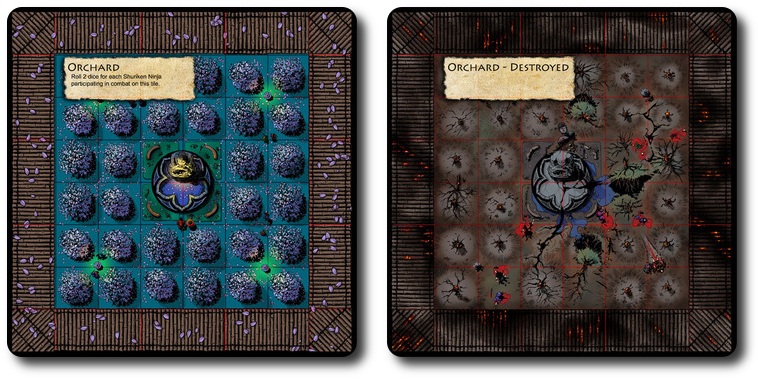
Note that some game board tiles (for example, the “Palace”) cannot be destroyed. If such is the case, the “Fire” symbols are ignored during combat.
Discard
This action allows the player to discard any number of their Mission cards and draw new ones to replace the discarded cards.
Once the player has taken their 3 actions, the next player in turn order sequence (going clockwise) now has their turn starting with step 2 noted above. If the next player to have their turn is the first player, the round is over.
Secret Ninja Missions
Each player starts with 3 Mission cards at the beginning of the game. These cards detail specific situations or game play states that must be in effect. If they are, the player can reveal their Mission card on their turn and place it in front of them. A completed Mission card will provide victory points and useful Ninja techniques, but not always and not necessarily both. Some Mission cards remain in front of the player throughout the duration of the game and some are discarded after they are used. Mission cards can also change the values being tracked on the player’s Clan card, but a Mission card cannot increase the number of Ninjas moved or the total number of squares spaces moved beyond the limits of the number values stated on the Clan cards.
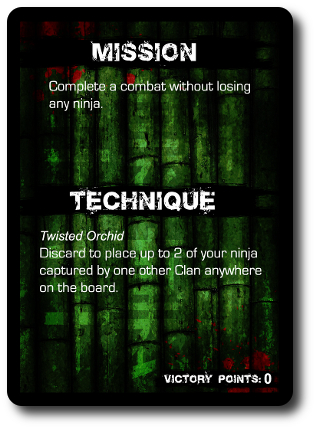
Once a player reveals a completed Mission card, they immediately draw a new one to replace it. If at any time a player has a Mission card that is impossible to complete, they can reveal it to the table, discard it, and draw a new one. This is different from the “Discard” action which allows a player to discard Mission cards that are possible to complete.
Sunrise and a New Clan Master
After the tenth round of the game, the sun rises and all the Ninja disperse leaving the Royal Guard to ponder how everything was destroyed. The Clan leaders then gather and determine which of the clans was the strongest. This is done by each player counting the total number of Ninjas they captured during combat and adding to that number any victory points earned through completed Mission cards. The player with most points is selected as the Clan Master and the winner of the game. In the event of a tie, the player with the most captured Ninjas is the winner.
Customization
Not included with our prototype copy were rules that allow for complete player customization and scenario driven game play. For example, the players could place the game board tiles in a specific pattern to represent a rival clan’s compound. Then, using that custom configuration, a scenario can be created that states something like, “the Clan that is holding the Dragon Fang Scrolls at the end of the game wins.” Using this example, Shuriken can be played like a game of capture the flag. But it need not stop there. Creative players will immediately see how easy it is to add to the game with custom Mission cards, custom Hour of Night cards, and even custom Clan cards. Undead Ninjas anyone? And why stop there? How about introducing explosives, smoke bombs, and traps? Not to mention some wicked Ninja magic! There is no limit to what can be added to the game other than a player’s inability to figuratively think outside the game box.
To learn more about Shuriken, visit the game’s web page or visit the Kickstarter campaign.
Prediction
Oh, good grief. This prediction isn’t even a challenge. I predict, with 100% accuracy, that all three of our groups will enjoy Shuriken. First of all, it has Ninjas. NINJAS!!!! Most gamers, be they Child, Parent, or Gamer Geeks like these silent assassins. Second, the game play reads fast and intuitive. Third, the different Ninja types and Mission cards allow players to make use of strategy and tactics. Fourth, NINJAS!!!!
I also predict I will hear a lot of grumbling from the players when we introduce them to and play Shuriken. The game component quality of the prototype we were given wasn’t that great. As previously mentioned, we were provided Zombies instead of Ninjas and the game board tiles were cut out paper. Usually, this wouldn’t even register with our players as they are all aware that the game they are playing is not yet finished. But a large part of what will be the game’s charm will be the Ninja miniatures and the proposed beautifully detailed game board tiles. Essentially, I’ll be putting in front of players a busted up and dropped pizza AFTER I show them a picture of a perfectly made and delicious looking pizza from a photo. You just know this will cause our groups to feel pretty put out.
Teaching Shuriken is very simple. In fact, and to put it in perspective, teaching Frag was more time-consuming and complicated. If you are familiar with Frag, that should tell you something right there. If you are not (and shame on you – you need to try the game), the most complicated aspect of Shuriken for new players is simply managing the large number of Ninjas that will be out on the game board tiles. But the game designers were very clever when it came to Ninja management. Players can only move so many Ninja and each Ninja can only travel so far. This makes the logistical deployment of large numbers of Ninja and their movement on the game board tiles very simple. In fact, when I put Shuriken in front of Gamer Geeks, it took only 2 minutes of game explanation, about 5 for the Parent Geeks (which included non-gamers), and a startling 10 minutes with the Child Geeks, but only because they kept interrupting me with excited jumps, cheers, and hand clapping.
Shuriken has combat, but any violence that is part of the flying fists and swinging swords is never visible. Ninjas are “captured”, not “killed”. This makes the game very family friendly. However, players need to be able to read in order to be competitive. I would suggest that the game is playable with Child Geeks as young as 5-years-old, but I somewhat doubt it. While a Parent Geek or an older sibling could read the Mission cards to the younger Child Geeks who cannot yet read, they will still be at a great disadvantage. This is because a player needs to keep in mind their Mission cards at all times in addition to managing all the Ninjas they have on the game board tiles. That’s just a bit too much to keep straight in the head for the younger Child Geeks. We’ll try the game with at least 1 5-year-old (because he is so super excited about the game), but I don’t think the game is yet within his grasp.
And so, after teaching the game to my two oldest little geeks, I asked them their thoughts on Shuriken so far.
“ARE YOU KIDDING ME!? NINJAS, DAD! NINJAS! LET’S PLAY ALREADY!!!!” ~ Liam (age 8)
“OH, YEAH! LET’S FIGHT DAD TOGETHER, LIAM! NINJA POOOOOOOOWWWWWEEEERRRRR!” ~ Nyhus (age 5)
Ha!
Let’s do this….
Final Word
Prepare to not be surprised.
The Child Geeks absolutely adored this game and stayed at the table despite most games being over an hour long. They played it well and with a level of excitement that was measurable from Mars. The younger Child Geeks who could not yet read were not able to play the game by themselves, but that didn’t stop them from teaming up with older Child Geeks, Parent Geeks, and Gamer Geeks. For those Child Geeks who were able to play the game, they demonstrated excellent strategy and tactics, as well as finishing a large number of their Mission cards. When the games were over, victory points were always close and there was never a “runaway winner”. According to one Child Geek, “THIS IS THE GREATEST GAME EVER!” Another less loud Child Geek said, “This is a really fun game to play and I felt like I was a Ninja Clan Leader from the very start! But why did we use Zombies?” All the Child Geeks voted to approve the game, thought it was funny that we used Zombies instead of Ninjas, and spilled an entire cup of juice on the “Palace” game board tile. (insert colorful expletive here)
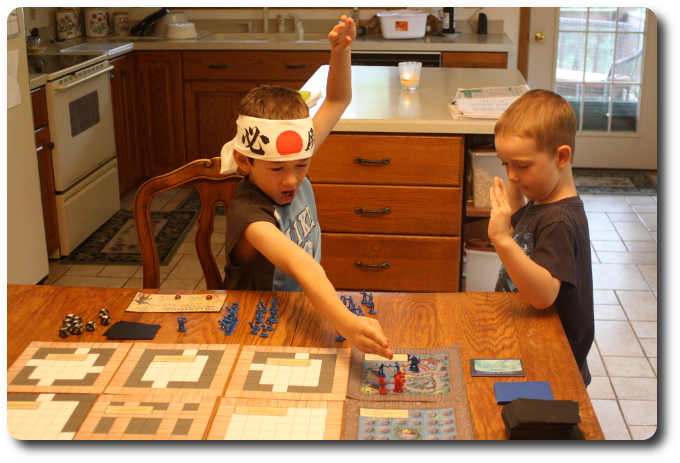
The Child Geeks demonstrate that their Kung Fu is strong…
The Parent Geeks, be they gamers or non-gamers, had a good time playing Shuriken. They enjoyed it as a family game and as a game to play with their peers. They were not impressed with the game components they played with, but really liked what the game was about and could see the final game being not only fun to play, but fun to play with. “What is going to make this game really good is the game bits and the game play. It’s a lethal combo,” said one Parent Geek. A non-gamer Parent Geek said, “I was surprised how much I liked the game and how easy it was to play. I am also surprised that I won.” All the Parent Geeks found Shuriken to be a fast game full of Ninja action, engaging, and entertaining. Especially when Ninjas engaged in combat and destroyed game board tiles. As an extra bonus, two of our non-gamer Parent Geeks, who knew nothing of Ninjas, learned more about the deadly assassins. “I think I like Pirates better, but Ninjas are pretty cool!” responded one Parent Geek after an intense game that resulted in a tie. All the Parent Geeks voted to approve Shuriken.
The Gamer Geeks had a blast with the game, gave me legendary amounts of grief about the game component quality, and were excited about what the game could be. One Gamer Geek said, pushing himself back from the gaming table, “I can see this game being endless fun when we have the ability to customize it. There’s a lot we can add to it.” All the Gamer Geeks were delighted with the level of thought that was needed to play the game at a highly competitive level or very little if the game was being played late at night. One Gamer Geek said, “This can be played like the beer and pretzel type games or like an intense combat game. Very cool.” Very cool, indeed! The only aspect of the game that the Gamer Geeks thought was a little goofy were some of the Mission cards being immediately completed. For example, one of the Mission cards states the player completes the mission if they have no “Sword” Ninjas on the game board tiles. This is a mission that can be completed immediately on a player’s turn, but there was some debate over the interpretation of the Mission card. Some thought the card implied that there should be no “Sword” Ninjas at all and some thought the Mission card was specific to the owning player. Regardless, all the Gamer Geeks voted to approve Shuriken and agreed it would make for a great addition to their elitist gaming table.
Boy, did I enjoy this game, but my level of enjoyment was GREATLY trumped by the game component bits. I so badly wanted to be running around with Ninjas that every time I moved a Zombie I felt disappointed. Luckily, all of our players remembered to base their opinion of the game on the game play and not the game bits. I was initially concerned and thought I’d be fighting an uphill battle when it came to explaining to our players that their final endorsement should be on their game playing experience and not the level of component quality of a not yet published game. And while the subject came up often, it had little to no impact on the players’ thought processes when it came time to cast their final vote. See? Ninjas are lucky.
Personally, I find Shuriken to be an excellent mix of light tactics and strategy. The game would have been so-so from a Gamer Geeks perspective if it just had Ninjas and the combat. With the addition of the Hour of Night and Mission cards, every player must constantly change how they play the game to small degrees. And I simply love that the players can destroy the game playing area. This forces players to think twice about putting all the Ninjas in a specific area and makes the game board a difficult place to navigate after large sections of it are smoking ruins. From start to finish, I had a great time with the game. I think this is the first Ninja themed game I have played that has left me feeling like I played a game that portrayed Ninjas and Ninja combat in a way that made sense, felt tactical, and was intense enough to have all the players lean in even if they weren’t part of the battle.
Do check out Shuriken. I think it’s going to be one of those games, if it’s made, that will be talked about for a long, long time. While not a game changer or introducing anything new to the gaming hobby, the game is solid, very well designed, and the proposed game bits are going to make it a topic of conversation. Just try not to like a game with so many Ninjas. I bet even Pirates are going to enjoy playing Shuriken.*
This game was given to Father Geek as a review copy. Father Geek was not paid, bribed, wined, dined, or threatened in vain hopes of influencing this review. Such is the statuesque and legendary integrity of Father Geek.
*BLASPHEMY!



